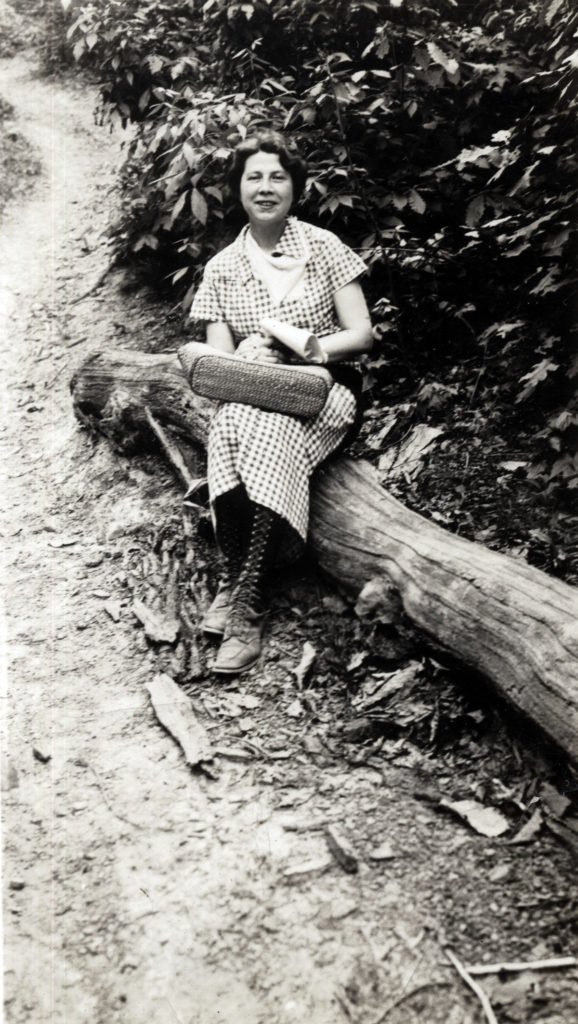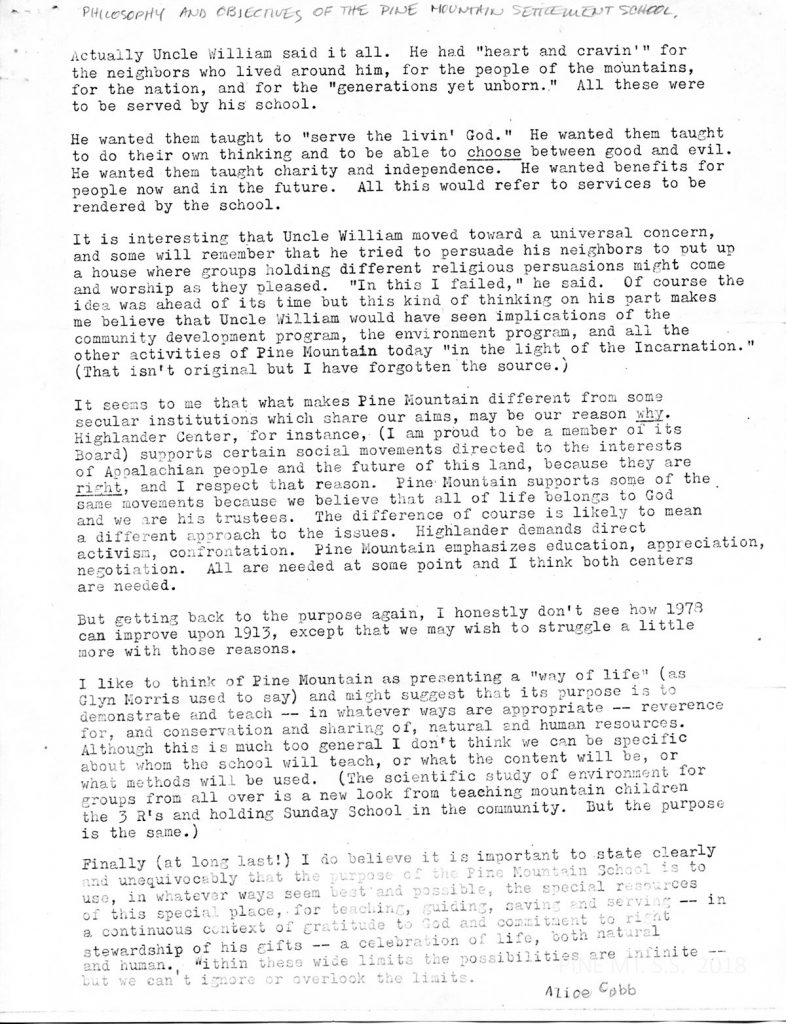Pine Mountain Settlement School
Series 05: ADMINISTRATION – BOARD OF TRUSTEES
Series 24: PUBLICATIONS RELATED
Alice Cobb
1978 Philosophy of PMSS

Alice Cobb on log. [cobb_alice_003.jpg]
ALICE COBB 1978 Philosophy of PMSS
ALICE COBB:
Secretary, Publicity 1932-1937
Teacher 1942-1952
Member, Board of Trustees 1977 -1983?
Fundraiser, Visitor, Consultant 1952-1995
TAGS: Alice Cobb, Pine Mountain Settlement School, philosophy, objectives, 1978, educational objectives, strategic planning, William Creech, Board of Trustees, mission, strategic planning, education, settlement schools, folk schools, Highlander Center, New Market, Tennessee, Myles Horton, secretaries, Christian social services, social services, Glyn Morris
I do believe it is important to state clearly and unequivocally that the purpose of Pine Mountain School is to use, in whatever way seems best and possible, the special resources of this special place, for teaching, guiding, saving and serving —in a continuous context of gratitude to God and commitment to right stewardship of his gifts — a celebration of life, both natural and human. Within these wide limits, the possibilities are infinite — but we can’t ignore or overlook the limits. — Alice Cobb, 1978
In Alice Cobb 1978 Philosophy and Objectives of PMSS it is not surprising to find Miss Cobb reflecting deeply on the past and future of the institution. Long associated with the School and long an outspoken advocate for social justice and for issues facing the people of the Central Appalachian mountains, here Cobb shares her views on the philosophy and objectives of Pine Mountain Settlement School through the lens of 1978. Written in response to a call for strategic planning of the Pine Mountain Board of Trustees in 1977, the document reflects on the history of the institution, its values, and mission as experienced.
Alice Cobb has a very long perspective, as she started working at the School in 1932 and served in various secretarial and administrative positions as well as fund-raising, until 1995. She was a continuous visitor to the campus of the School. Within her perspective, she captures the essence of what many have come to call the “Spirit of Pine Mountain.”
TRANSCRIPTION
REFLECTIONS ON THE PHILOSOPHY AND OBJECTIVES OF PMSS
Actually, Uncle William said it all. He had “heart and cravin'” for the neighbors who lived around him, for the people of the mountains, for the nation and for the “generations yet unborn.” all these were to be served by his school.
He wanted them taught to “serve the livin’ God.” He wanted them taught to do their own thinking and to be able to choose between good and evil. He wanted them taught charity and independence. He wanted benefits for people now and in the future. all this would refer to services to be rendered by the school.
It is interesting that Uncle William moved toward a universal concern, and some will remember that he tried to persuade his neighbors to put up a house where groups holding different religious persuasions might come and worship as they pleased. “In this, I failed,” he said. Of course, the idea was ahead of its time but this kind of thinking on his part makes me believe that Uncle William would have seen implications of the community development program, the environment program, and all the other activities of Pine Mountain today “in the light of the Incarnation.” (That isn’t original but I have forgotten the source.)
It seems to me that what makes Pine Mountain different from some secular institutions which share our aims, may be our reason why. Highlander Center, for instance, (I am proud to be a member of its Board) supports certain social movements directed to the interests of Appalachian people and the future of this land, because they are right, and I respect that reason, Pine Mountain supports some of the same movements because we believe that all of life belongs to God and we are his trustees. The difference of course is likely to mean a different approach to the issues. Highlander demands direct activities, confrontation. Pine Mountain emphasizes education, appreciation, negotiation. All are needed at some point and I think both centers are needed.
But getting back to the purpose again, I honestly don’t see how 1978 can improve upon 1913, except that we may wish to struggle a little more with those reasons.
I like to think of Pine Mountain as presenting a “way of life” (as Glyn Morris used to say) and might suggest that its purpose is to demonstrate and teach — in whatever ways are appropriate — reverence for, and conservation and sharing of, natural and human resources. Although this is much too general I don’t think we can be specific about whom the school will teach, or what the content will be, or what methods will be used. (The scientific study of environment for groups from all over is a new look from teaching mountain children the 3 R’s and holding Sunday School in the community. But the purpose is the same.)
Finally, (at long last!) I do believe it is important to state clearly and unequivocally that the purpose of Pine Mountain School is to use, in whatever way seems best and possible, the special resources of this special place, for teaching, guiding, saving and serving — in a continuous context of gratitude to God and commitment to right stewardship of his gifts — a celebration of life, both natural and human. Within these wide limits, the possibilities are infinite — but we can’t ignore or overlook the limits.
Alice Cobb
GALLERY: ALICE COBB 1978 Philosophy of PMSS

ALICE COBB 1978 Philosophy and Objectives of PMSS. [pmss_philosophy_1977_kingman_003.jpg]
Return To:
GOVERNANCE 1977-78 Philosophy of Pine Mountain Settlement School
See Also:
ALICE COBB GUIDE TO Writing, Stories, and Letter Copies
ALICE COBB Staff – Biography
ALICE COBB – TRAVELOGUE, 1941
ALICE COBB – TRAVELOGUE, 1942
ALICE COBB – TRAVELOGUE 1944 for Trustee Dorothy Elsmith
ALICE COBB – TRAVELOGUE, 1946
ALICE COBB “SNAPS” PHOTO ALBUM

